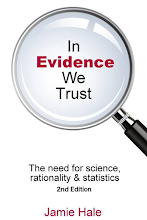You are biased and so is everyone else. “I am not biased” says the uninformed consumer, researcher, policy maker, minister, spiritual guru, coach, therapist etc.......
Myside bias: is the tendency for people to evaluate evidence, generate evidence, and test hypotheses in a manner biased toward their own opinions. The weight of evidence doesn’t matter when making decisions or determining belief. It is reasonable to suggest everyone is influenced at some level of bias (conscious and unconscious- not being aware of bias).Bias Blind Spot
“Research involving the assessment of one’s own biases indicates people
often feel that they are less biased than others. Bias blind spot is
conceptualized as a tendency to recognize bias in others, while not recognizing
bias in ourselves (Pronin et al. 2002). Emily Pronin and colleagues conducted a
study that asked participants to rate themselves and others on their
susceptibility to a variety of biases. The results indicated across eight
biases people felt they were less biased than their peers. In summary, people
acknowledge the value of scientific findings on biased processing, but they
don’t believe those findings apply to them.
Intelligence & Myside Processing
Toplak &
Stanovich (2003) presented 112 undergraduate university students with an
informal reasoning test in which they were asked to generate arguments both for
and against the position they endorsed on three separate issues. Performance on
the task was evaluated by comparing the number of arguments they generated
which endorsed (myside arguments) and which refuted (otherside arguments) their
own position on that issue. Participants generated more myside arguments than
otherside arguments on all three issues, thus consistently showing a myside
bias effect on each issue. Differences in cognitive ability were not associated
with individual differences in myside bias. However, year in university was a
significant predictor of myside bias. The degree of myside bias decreased
systematically with year in university. Year in university remained a
significant predictor of myside bias even when both cognitive ability and age
were statistically partialled out. Myside bias was displayed on all three issues, but
there was no association in the level of myside bias shown across the different issues Read more Proxies of
Intelligence Do Not Predict Avoidance of Myside Bias




